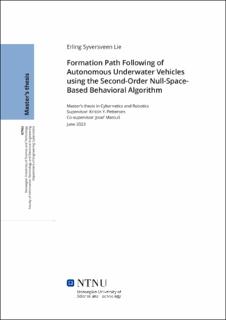| dc.contributor.advisor | Pettersen, Kristin Y. | |
| dc.contributor.advisor | Matouš, Josef | |
| dc.contributor.author | Lie, Erling Syversveen | |
| dc.date.accessioned | 2023-09-19T17:20:04Z | |
| dc.date.available | 2023-09-19T17:20:04Z | |
| dc.date.issued | 2023 | |
| dc.identifier | no.ntnu:inspera:140443607:35004970 | |
| dc.identifier.uri | https://hdl.handle.net/11250/3090581 | |
| dc.description.abstract | Denne oppgaven presenterer en ny styringsmetode for formasjonsbanefølging med autonome undervannsfartøy ved hjelp av en andreordens nullromsbasert atferdsmetode. Autonome undervannsfartøy byr på unike utfordringer innen formasjonsbanefølging på grunn av deres ulineære og underaktuerte natur. Målet med oppgaven er å utnytte inngang-utgang-linearisering ved hjelp av håndposisjonskonseptet for å muliggjøre anvendelse av formasjonsstyringsmetoder som er utviklet for dobbelt-integrator-systemer, som ellers ikke ville vært anvendelige for autonome undervannsfartøy.
Det viktigste bidraget i dette arbeidet er utvidelsen av den nullromsbaserte metoden til å direkte håndtere den iboende andreordens dynamikken til undervannsfartøy gjennom det inngang-utgang lineariserte dobbelt-integrator systemet. Ved å ta hensyn til all dynamikken i oppgaverommet, eliminerer metoden tilstedeværelsen av skjulte dynamikker fra lavnivåkontroll, som man støter på i førsteordens metoder. Styringsmetoden bruker håndposisjonskonseptet for å tranformere den underaktuerte seks-graders-frihet fartøymodellen til et dobbelt-integrator-system. Den nullromsbaserte atferdsmetoden muliggjør opprettelsen av et hierarki av prioriterte oppgaver. For å løse formasjonsbanefølgingsproblemet definerer vi tre oppgaver: kollisjonsungåelse, formasjonsvedlikehold og banefølging. Den andreordens formuleringen av den nullromsbaserte atferdsmetoden muliggjør å uttrykke all dynamikken til systemet direkte i oppgaverommet.
Først utvikles en sentralisert metode som likner mye på de førsteordens nullromsbaserte metodene som allerede finnes i litteraturen. Deretter, på grunn av praktiske begrensninger i virkelige anvendelser, presenterer vi en ny distribuert versjon av metoden. Denne distribuerte metoden omformulerer formasjonsvedlikeholdsoppgaven som et konsensusproblem, og muliggjør ulike kommunikasjonstopologier uten krav om at hvert fartøy må kommunisere med alle andre. Styringsloven utnytter teknikker fra "sliding mode" regulatorer for å eliminere feil grunnet ukomplett kommunikasjons graf.
Lukket-sløyfe-systemet for formasjonsvedlikehold og banefølging analyseres ved hjelp av Lyapunov-teori. Vi viser at den sentraliserte metoden gir et uniformt semi-globalt asymptotisk stabilt system, mens løsningene til systemet under den desentraliserte metoden er til slutt avgrenset til et vilkårlig lite område avhengig av valg av approksimasjon av det diskontinuerlige leddet i "sliding mode" regulatoren. Med en ideell diskontinuerlig regulator er systemet asymptotisk stabilt.
Metodens effektivitet demonstreres gjennom omfattende simuleringsstudier i MATLAB. Både den sentraliserte og distribuerte metoden testes under ulike scenarioer, og den distribuerte metoden sammenliknes med eksisterende metoder fra litteraturen. Det demonstreres at den andreordens nullromsbaserte atferdsmetoden har lavere feil i likevekt sammenliknet med andre metoder. Resultatene viser potensialet til den andreordens nullromsbaserte metoden for å oppnå nøyaktig formasjonsbanefølging for autonome undervannsfartøy. | |
| dc.description.abstract | This thesis presents a novel control law for formation path following with autonomous underwater vehicles (AUVs) using a second-order null-space-based behavioral (NSB) method. AUVs pose unique challenges in formation control due to their nonlinear and underactuated nature. This thesis aims to leverage the input-output linearizing hand-position controller to enable the application of formation control methods designed for double-integrator systems, that would otherwise not be applicable to AUVs.
The main contribution of this work is the extension of the NSB method to directly handle the inherent second-order dynamics of AUVs, addressing the double-integrator nature of the system. By directly accounting for these dynamics, the method eliminates the presence of hidden dynamics from low-level control, encountered in first-order methods. The control algorithm utilizes a hand-position controller that transforms the underactuated six-degrees-of-freedom AUV model into a double-integrator system. The NSB method is a behavioral control algorithm that enables the creation of a hierarchy of prioritized tasks. To solve the formation-path-following problem, we create three tasks: collision avoidance, formation keeping, and path following. The second-order formulation enables the expression of all dynamics directly in task space.
The method is initially developed centralized, closely linked to the first-order NSB methods in the literature. However, due to practical limitations in real-world applications, a novel distributed version of the NSB algorithm is proposed. This distributed method reformulates the formation-keeping task as a consensus problem, enabling different communication topologies without requiring each vehicle to communicate with all others. The control law leverages techniques from sliding mode control to eliminate errors resulting from non-complete communication graphs.
The closed-loop formation-control and path-following systems are analyzed using Lyapunov theory. The centralized method is shown to give a uniformly semi-globally exponentially stable (USGES) system while the decentralized method is shown to provide trajectories that are ultimately bounded to an arbitrarily small set depending on the approximation of the switching term in the sliding mode controller. With an ideal switching controller, the system is shown to be asymptotically stable.
The method's effectiveness is then demonstrated through extensive MATLAB simulation studies. Both the centralized and distributed methods are tested under a range of different scenarios, and the distributed method is compared with existing methods from the literature. The second-order NSB method is demonstrated to have lower steady-state errors compared to other methods. The results demonstrate the potential of the second-order NSB method for achieving accurate formation control and path following with AUVs. | |
| dc.language | eng | |
| dc.publisher | NTNU | |
| dc.title | Formation Path Following of Autonomous Underwater Vehicles using the Second-Order Null-Space-Based Behavioral Algorithm | |
| dc.type | Master thesis | |
